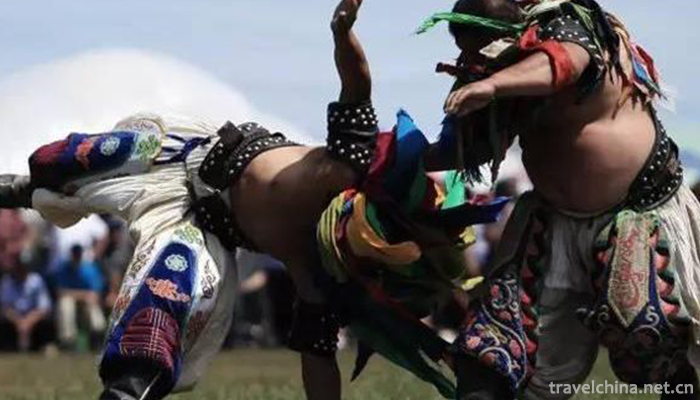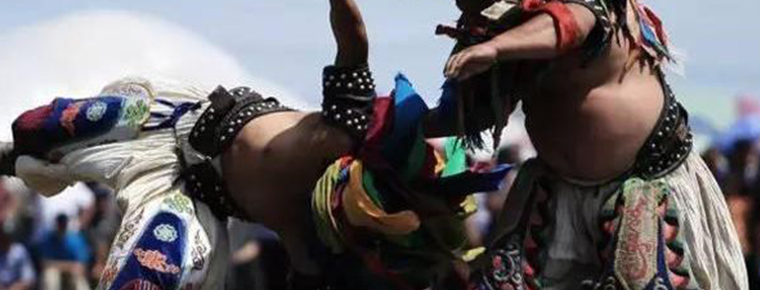Nadam
Nadam
Nadamu is Mongolian, also known as Nair. Nadamu is a Mongolian transliteration, meaning "entertainment, games" to express the joy of harvest. The Nadamu Congress is a traditional festival with a long history of the Mongolian people and occupies an important position in the life of the Mongolian people.
Every year in July and August, the "Nadamu" congress, held in the season of livestock fattening, is a cultural and recreational Congress held to celebrate the harvest. "Nadam" means entertainment or games in Mongolian. There were thrilling horse racing and wrestling, admirable archery, competitive chess skills, and fascinating singing and dancing at the Nadam Convention. Horse racing is also one of the important events at the conference. At the beginning of the competition, the riders lined up, each wearing colored belts and headbands, brimming with youthful vitality. Horse racing starts and ends with colorful flags, waiting for the horn to ring, riders will fly saddles, whip the horse, red scarves fly, such as arrows and arrows. The top five arrived at the destination and became the most praised health kid on the grassland. Archery, wrestling and other competitions also attract many herdsmen.
Nadamu, which starts on the fourth day of June of the lunar calendar every year for five days, is a grand occasion for the Mongolian people. The contents of the Nadam Municipal Congress are mainly wrestling, horse racing, archery, horse roping, Mongolian chess and other traditional ethnic events. In some places, there are sports such as track and field, tug of war, basketball and so on.
On May 20, 2006, Nadam was listed in the first batch of national intangible cultural heritage list with the approval of the State Council.
Historical Development
The Nadamu Congress is a grand gathering of the Mongolian, Ewenki and Daur minority peoples living in Inner Mongolia Autonomous Region and other places. "Nadamu" is a transliteration of Mongolian, meaning "entertainment" and "game". It is held in summer and autumn every year. During the congress, farmers and herdsmen from all over the country rode horses and drove cars with fur, medicinal materials and other agricultural and animal husbandry products. Groups of people gathered in the square of the congress. Coloured Mongolian yurts were set up on the green grasslands around the venue.
"Nadamu" is ancient and sacred in the heart of the Mongolian people. It has a long history. The earliest recorded activity of Nadamu was Genghis Khan inscribed on the rocky cliff in the Mongolian language of Wuwuer (ancient Mongolian) in 1225.
In the Yuan and Ming dynasties, archery, horse racing and wrestling competitions were combined to form three men's events, which formed the fixed form of the "Nadamu" competition.
In the Qing Dynasty, "Nadamu" gradually became an organized and purposeful recreational activity convened regularly by the government, and its scale, form and content developed more than before. At that time, the Mongolian princes held a "Nadamu" conference half a year, one year or three years in Sumu (quite a district), banner and League units, and awarded the winners of the competition with grades and titles. But at that time, owing to the dark box manipulation of the princes and nobles, the wrestlers, horse racers and archers of the princes often won the championship in Nadam Mu.
Origin of activity
Nadamu's predecessor is the Mongolian "Sacrifice to Aobao", which is the Mongolian nation in the long nomadic life, created and handed down with a unique national color of sports and recreation, sports.
Nadam has a long history. According to the stone inscription of Genghis Khan inscribed on the cliff, Nadam originated in the early days of the establishment of the Mongolian Khanate. As early as 1206 AD, when Genghis Khan was promoted as the Mongolian Khan, he held a "Great Hurley Gathering" between July and August every year to inspect his troops and maintain and distribute grasslands, bringing together the leaders of various tribes to express solidarity and friendship. Nadam is to be held for the harvest celebration. At first, only one event of archery, horse racing or wrestling was held. By the Yuan and Ming Dynasties, archery, horse racing and wrestling competitions were combined into a fixed form. Later, the Mongolian people also referred to these three sports as the basic project of Nadam for men.
During the Yuan Dynasty, Nadam Mu was widely developed in Mongolian grassland areas and gradually became a military sport. The rulers of the Yuan Dynasty stipulated that Mongolian men must have three basic skills: wrestling, horseback riding and archery. By the Qing Dynasty, Nadam had gradually become an organized and purposeful recreational activity convened regularly by the government. It was held half a year, one year or three years in units of Sumu (equivalent to township), banner and alliance. Since then, the Mongolian people have held Nadam every year.
In the past, large-scale sacrificial activities were carried out in Nadam. Lamas burned incense and lit lamps, chanted sutras and praised Buddhas, prayed for the blessings of gods, and relieved disasters. Nadamu's content mainly includes wrestling, horse racing, archery, Saibu, horse roping, Mongolian chess and other traditional ethnic events. In some places, there are sports competitions such as track and field, tug of war, volleyball, basketball and so on. In addition, there are martial arts, polo, horse riding, archery, horse chopping, horse race walking, horse riding skills, motorcycles and other wonderful performances in Nadam. The horse who takes part in the race must be trained specially. His four feet cannot leave the ground at the same time. He can only walk fast and cannot run fast. Night falls, the prairie is fluttering with the melodious and exciting harp sound, the young men and women singing and dancing by the campfire, and people are immersed in the joy of the festival.


-
1.Kunming CityStone Forest Scenic
Kunming Stone Forest Scenic Area, also known as Yunnan Stone Forest
Time 2018-10-21 -
2.Donkey HamBurger
Donkey HamBurger is a popular traditional snack in North China. It originated in Baoding. Widely spread in the central Hebei Plain, the brine good donkey meat adds the old soup to join the crispy fire
Time 2018-11-07 -
3.Lushan Karst Cave Group Scenic Area
Yiyuan Karst Cave Group is located in Nanlushan Town, 7 kilometers northwest of Yiyuan County. It has been proved that there are more than 100 caves in the area of 5 square kilometers around the ape-m
Time 2019-02-06 -
4.Buyi Eight tone Sitting Singing
Buyi eight-tone sitting-singing, also known as "Buyi eight-tone", is a form of folk music and singing handed down from generation to generation by the Buyi people
Time 2019-04-04 -
5.Winter capture of Chagan Lake
Winter fishing in Chagan Lake, namely ice and snow fishing (or hunting) in Chagan Lake in winter, is a traditional fishery production mode (custom) in Qianguoerros Mongolian Autonomous County
Time 2019-04-15 -
6.The Story of Duzhenwan
Duzhenwan stories cover myths and legends, life stories, ghosts, foxes, ghosts and other fields, including conspiracy, good and evil, kindness and hatred and other different types
Time 2019-04-28 -
7.Fengyang flower drum
Fengyang flower drum is also known as "flower drum", "beating flower drum", "flower drum gong", "double drum" and so on. Fengyang flower drum originated in Linh
Time 2019-04-29 -
8.Bow and Arrow Making Skills
Juyuan bow and arrow making technology, the traditional handicraft of Chaoyang District, Beijing, is one of the national intangible cultural heritage.
Time 2019-05-01 -
9.Shangluo Flower Drum
Shangluo Flower Drum, also known as Flower Drum and Ground Bumper, is popular in 7 counties (districts) of Shangluo City, Shaanxi Province, especially in Shangzhou, Danfeng, Zhenan and Zhashui. During
Time 2019-06-13 -
10.Uygur Folk Songs
Uygur folk songs are rich in content, which can be divided into two parts: traditional folk songs and new folk songs. Traditional folk songs include love songs, labor songs, historical songs, Life son
Time 2019-06-26 -
11.Encouragement of Miao Nationality in Western Hunan
Encouraged by the Miao people in Western Hunan Province, the traditional dance of Tujia and Miao Autonomous Prefecture in Western Hunan Province is one of the national intangible cultural heritage.
Time 2019-07-03 -
12.Yandi Festival
"Yandi Mausoleum Festival" is divided into official and folk sacrifices. Folk sacrifice began in summer, official sacrifice originated in Zhou, and Emperor sacrifice originated in Tang Dynas
Time 2019-07-10